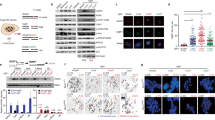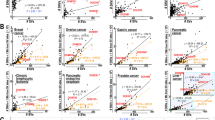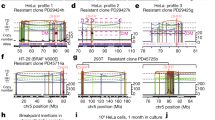Abstract
A prominent feature of most cancers including Barrett's adenocarcinoma (BAC) is genetic instability, which is associated with development and progression of disease. In this study, we investigated the role of recombinase (hsRAD51), a key component of homologous recombination (HR)/repair, in evolving genomic changes and growth of BAC cells. We show that the expression of RAD51 is elevated in BAC cell lines and tissue specimens, relative to normal cells. HR activity is also elevated and significantly correlates with RAD51 expression in BAC cells. The suppression of RAD51 expression, by short hairpin RNA (shRNA) specifically targeting this gene, significantly prevented BAC cells from acquiring genomic changes to either copy number or heterozygosity (P<0.02) in several independent experiments employing single-nucleotide polymorphism arrays. The reduction in copy-number changes, following shRNA treatment, was confirmed by Comparative Genome Hybridization analyses of the same DNA samples. Moreover, the chromosomal distributions of mutations correlated strongly with frequencies and locations of Alu interspersed repetitive elements on individual chromosomes. We conclude that the hsRAD51 protein level is systematically elevated in BAC, contributes significantly to genomic evolution during serial propagation of these cells and correlates with disease progression. Alu sequences may serve as substrates for elevated HR during cell proliferation in vitro, as they have been reported to do during the evolution of species, and thus may provide additional targets for prevention or treatment of this disease.
This is a preview of subscription content, access via your institution
Access options
Subscribe to this journal
Receive 50 print issues and online access
$259.00 per year
only $5.18 per issue
Buy this article
- Purchase on Springer Link
- Instant access to full article PDF
Prices may be subject to local taxes which are calculated during checkout







Similar content being viewed by others
References
Abdurashitov MA, Tomilov VN, Chernukhin VA, Degtyarev S . (2008). A physical map of human Alu repeats cleavage by restriction endonucleases. BMC Genomics 9: 305.
Aggarwal S, Taneja N, Lin L, Orringer MB, Rehemtulla A, Beer DG . (2000). Indomethacin induced apoptosis in esophageal adenocarcinoma cells involves upregulation of Bax and translocation of mitochondrial cytochrome C independent of COX-2 expression. Neoplasia 2: 346–356.
Akagi T, Ito T, Kato M, Jin Z, Cheng Y, Kan T et al. (2009). Chromosomal abnormalities and novel disease-related regions in progression from Barrett's esophagus to esophageal adenocarcinoma. Int J Cancer 125: 2349–2359.
Baker BS, Carpenter AT, Esposito MS, Esposito RE, Sandler L . (1976). The genetic control of meiosis. Annu Rev Genet 10: 53–134.
Barlund M, Monni O, Kononen J, Cornelison R, Torhorst J, Sauter G et al. (2000). Multiple genes at 17q23 undergo amplification and overexpression in breast cancer. Cancer Res 60: 5340–5344.
Bastos HN, Antao MR, Silva SN, Azevedo AP, Manita I, Teixeira V et al. (2009). Association of polymorphisms in genes of the homologous recombination DNA repair pathway and thyroid cancer risk. Thyroid 19: 1067–1075.
Baumann P, Benson FE, West SC . (1996). Human Rad51 protein promotes ATP-dependent homologous pairing and strand transfer reactions in vitro. Cell 87: 757–766.
Beerenwinkel N, Antal T, Dingli D, Traulsen A, Kinzler KW, Velculescu VE et al. (2007). Genetic progression and the waiting time to cancer. PLoS Comput Biol 3: e225.
Bishop AJ, Schiestl RH . (2003). Role of homologous recombination in carcinogenesis. Exp Mol Pathol 74: 94–105.
Brookfield JF . (1994). The human Alu SINE sequences--is there a role for selection in their evolution? Bioessays 16: 793–795.
Brunner AM, Schimenti JC, Duncan CH . (1986). Dual evolutionary modes in the bovine globin locus. Biochemistry 25: 5028–5035.
Cai JC, Liu D, Liu KH, Zhang HP, Zhong S, Xia NS . (2008). Microsatellite alterations in phenotypically normal esophageal squamous epithelium and metaplasia-dysplasia-adenocarcinoma sequence. World J Gastroenterol 14: 4070–4076.
Cheng RZ, Shammas MA, Li J, Shmookler Reis RJ . (1997). Expression of SV40 large T antigen stimulates reversion of a chromosomal gene duplication in human cells. Exp Cell Res 234: 300–312.
Croft J, Parry EM, Jenkins GJ, Doak SH, Baxter JN, Griffiths AP et al. (2002). Analysis of the premalignant stages of Barrett′s oesophagus through to adenocarcinoma by comparative genomic hybridization. Eur J Gastroenterol Hepatol 14: 1179–1186.
Economou-Pachnis A, Tsichlis PN . (1985). Insertion of an Alu SINE in the human homologue of the Mlvi-2 locus. Nucleic Acids Res 13: 8379–8387.
Economou-Pachnis A, Lohse MA, Furano AV, Tsichlis PN . (1985). Insertion of long interspersed repeated elements at the Igh (immunoglobulin heavy chain) and Mlvi-2 (Moloney leukemia virus integration 2) loci of rats. Proc Natl Acad Sci USA 82: 2857–2861.
Farber E . (1984). The multistep nature of cancer development. Cancer Res 44: 4217–4223.
Finley JC, Reid BJ, Odze RD, Sanchez CA, Galipeau P, Li X et al. (2006). Chromosomal instability in Barrett′s esophagus is related to telomere shortening. Cancer Epidemiol Biomarkers Prev 15: 1451–1457.
Frank B, Hoffmeister M, Klopp N, Illig T, Chang-Claude J, Brenner H . (2010). Colorectal cancer and polymorphisms in DNA repair genes WRN, RMI1 and BLM. Carcinogenesis 31: 442–445.
Galli A, Schiestl RH . (1995). On the mechanism of UV and gamma-ray-induced intrachromosomal recombination in yeast cells synchronized in different stages of the cell cycle. Mol Gen Genet 248: 301310.
Gee CJ, Harris H . (1979). Tumorigenicity of cells transformed by Simian virus 40 and of hybrids between such cells and normal diploid cells. J Cell Sci 36: 223–240.
Graves JAM . (2004). The degenerate Y chromosome-can conversion save it? Reprod Fertility Dev 16: 527–534.
Graves JA . (2006). Sex chromosome specialization and degeneration in mammals. Cell 124: 901–914.
Hansen LT, Lundin C, Spang-Thomsen M, Petersen LN, Helleday T . (2003). The role of RAD51 in etoposide (VP16) resistance in small cell lung cancer. Int J Cancer 105: 472–479.
Hess JF, Fox M, Schmid C, Shen CK . (1983). Molecular evolution of the human adult alpha-globin-like gene region: insertion and deletion of Alu family repeats and non-Alu DNA sequences. Proc Natl Acad Sci USA 80: 5970–5974.
Honma M, Zhang LS, Hayashi M, Takeshita K, Nakagawa Y, Tanaka N et al. (1997). Illegitimate recombination leading to allelic loss and unbalanced translocation in p53-mutated human lymphoblastoid cells. Mol Cell Biol 17: 4774–4781.
Horii A, Nakatsuru S, Miyoshi Y, Ichii S, Nagase H, Kato Y et al. (1992). The APC gene, responsible for familial adenomatous polyposis, is mutated in human gastric cancer. Cancer Res 52: 3231–3233.
Jara L, Dubois K, Gaete D, de Mayo T, Ratkevicius N, Bravo T et al. (2010). Variants in DNA double-strand break repair genes and risk of familial breast cancer in a South American population. Breast Cancer Res Treat 122: 813–822.
Jones S, Chen WDm Parmigiani G, Diehl F, Beerenwinkel N, Antal T, Traulsen A et al. (2008). Comparative lesion sequencing provides insights into tumor evolution. Proc Natl Acad Sci USA 105: 4283–4288.
Kolomietz E, Meyn MS, Pandita A, Squire JA . (2002). The role of Alu repeat clusters as mediators of recurrent chromosomal aberrations in tumors. Genes Chromosomes Cancer 35: 97–112.
Koppert LB, Wijnhoven BP, van Dekken H, Tilanus HW, Dinjens WN . (2005). The molecular biology of esophageal adenocarcinoma. J Surg Oncol 92: 169–190.
Lengauer C, Kinzler KW, Vogelstein B . (1997). Genetic instability in colorectal cancers. Nature 386: 623–627.
Lengauer C, Kinzler KW, Vogelstein B . (1998). Genetic instabilities in human cancers. Nature 396: 643–649.
Li C, Wong WH . (2001). Model-based analysis of oligonucleotide arrays: expression index computation and outlier detection. Proc Natl Acad Sci USA 98: 31–36.
Li H, Hong F . (2001). Cluster-Rasch models for microarray gene expression data. Genome Biol 2 (8): Research0031.1–0031.13.
Li C, Hung Wong W . (2001). Model-based analysis of oligonucleotide arrays: model validation, design issues and standard error application. Genome Biol 2: RESEARCH0032.
Li J, Ayyadevera R, Shmookler Reis RJ . (1997). Carcinogens stimulate intrachromosomal homologous recombination at an endogenous locus in human diploid fibroblasts. Mutat Res 385: 173–193.
Lynch HT, Lynch JF . (1998). Genetics of colonic cancer. Digestion 59: 481–492.
Lynch HT, Smyrk T, Lynch JF . (1998). Molecular genetics and clinical-pathology features of hereditary nonpolyposis colorectal carcinoma (Lynch syndrome): historical journey from pedigree anecdote to molecular genetic confirmation. Oncology 55: 103–108.
Maacke H, Jost K, Opitz S, Miska S, Yuan Y, Hasselbach L et al. (2000). DNA repair and recombination factor Rad51 is over-expressed in human pancreatic adenocarcinoma. Oncogene 19: 2791–2795.
Maciejewski JP, Mufti GJ . (2008). Whole genome scanning as a cytogenetic tool in hematologic malignancies. Blood 112: 965–974.
Miki H, Ohmori M, Perantoni AO, Enomoto T . (1991). K-ras activation in gastric epithelial tumors in Japanese. Cancer Lett 58: 107–113.
Miki Y, Nishisho I, Horii A, Miyoshi Y, Utsunomiya J, Kinzler KW et al. (1992). Disruption of the APC gene by a retrotransposal insertion of L1 sequence in a colon cancer. Cancer Res 52: 643–645.
Munshi NC, Hideshima T, Carrasco D, Shammas M, Auclair D, Davies F et al. (2004). Identification of genes modulated in multiple myeloma using genetically identical twin samples. Blood 103: 1799–1806.
Munshi NC, Hideshima T, Carrasco D, Shammas M, Auclair D, Davies F et al. (2004). Identification of genes modulated in multiple myeloma using genetically identical twin samples. Blood 103: 1799–1806.
Neiman PE, Hartwell LH . (1991). Malignant instability. Workshop on genetic instability and its role in carcinogenesis sponsored by the Programs in Molecular Medicine of the Fred Hutchinson Cancer Research Center and the University of Washington, Seattle, WA, USA, January 11–12, 1991. New Biol 3: 347–351.
Ogunwobi OO, Beales IL . (2008). Statins inhibit proliferation and induce apoptosis in Barrett′s esophageal adenocarcinoma cells. Am J Gastroenterol 103: 825–837.
Pathak S, Dave BJ, Gagos S . (1994). Chromosome alterations in cancer development and apoptosis. In vivo 8: 843–850.
Paulson TG, Maley CC, Li X, Li H, Sanchez CA, Chao DL et al. (2009). Chromosomal instability and copy number alterations in Barrett′s esophagus and esophageal adenocarcinoma. Clin Cancer Res 15: 3305–3314.
Rabinovitch PS, Reid BJ, Haggitt RC, Norwood TH, Rubin CE . (1989). Progression to cancer in Barrett′s esophagus is associated with genomic instability. Lab Invest 60: 65–71.
Radman M, Jeggo P, Wagner R . (1982). Chromosomal rearrangement and carcinogenesis. Mutat Res 98: 249–264.
Resnick MA, Skaanild M, Nilsson-Tillgren T . (1989). Lack of DNA homology in a pair of divergent chromosomes greatly sensitizes them to loss by DNA damage. Proc Natl Acad Sci USA 86: 2276–2280.
Rodarte-Ramon US . (1972). Radiation-induced recombination in Saccharomyces: the genetic control of recombination in mitosis and meiosis. Radiat Res 49: 148–154.
Romagnoli S, Roncalli M, Graziani D, Cassani B, Roz E, Bonavina L et al. (2001). Molecular alterations of Barrett′s esophagus on microdissected endoscopic biopsies. Lab Invest 81: 241–247.
Schimenti JC, Duncan CH . (1984). Ruminant globin gene structures suggest an evolutionary role for Alu-type repeats. Nucleic Acids Res 12: 1641–1655.
Sengstag C . (1994). The role of mitotic recombination in carcinogenesis. Crit Rev Toxicol 24: 323–353.
Shammas MA, Neri P, Koley H, Batchu RB, Bertheau RC, Munshi V et al. (2006). Specific killing of multiple myeloma cells by (-)-epigallocatechin-3gallate extracted from green tea: biologic activity and therapeutic implications. Blood 108: 2804–2810.
Shammas MA, Xia SJ, Shmookler Reis RJ . (1997). Induction of duplication reversion in human fibroblasts, by wild-type and mutated SV40 T antigen, covaries with the ability to induce host DNA synthesis. Genetics 146: 1417–1428.
Shammas MA, Simmons CG, Corey DR, Reis RJ . (1999). Telomerase inhibition by peptide nucleic acids reverses ′immortality′ of transformed human cells. Oncogene 18: 6191–6200.
Shammas MA, Shmookler Reis RJ, Akiyama M, Koley H, Chauhan D, Hideshima T et al. (2003). Telomerase inhibition and cell growth arrest by Gquadruplex interactive agent in multiple myeloma. Mol Cancer Therapeut 2: 825–833.
Shammas MA, Koley H, Beer DG, Li C, Goyal RK, Munshi NC . (2004). Growth arrest, apoptosis, and telomere shortening of Barrett's-associated adenocarcinoma cells by a telomerase inhibitor. Gastroenterology 126: 1337–1346.
Shammas MA, Koley H, Batchu RB, Bertheau RC, Protopopov A, Munshi NC et al. (2005). Telomerase inhibition by siRNA causes senescence and apoptosis in Barrett′s adenocarcinoma cells: mechanism and therapeutic potential. Mol Cancer 4: 24.
Shammas MA, Qazi A, Batchu RB, Bertheau RC, Wong JY, Rao MY et al. (2008). Telomere maintenance in laser capture microdissection purified Barrett's adenocarcinoma cells and effect of telomerase inhibition in vivo. Clin Cancer Res 14: 4971–4980.
Shammas MA, Shmookler Reis RJ, Koley H, Batchu RB, Li C, Munshi NC . (2009). Dysfunctional homologous recombination mediates genomic instability and progression in myeloma. Blood 113: 2290–2297.
Silva SN, Tomar M, Paulo C, Gomes BC, Azevedo AP, Teixeira V et al. (2010). Breast cancer risk and common single nucleotide polymorphisms in homologous recombination DNA repair pathway genes XRCC2, XRCC3, NBS1 and RAD51. Cancer Epidemiol 34: 85–92.
Singer MF . (1982). SINEs and LINEs: highly repeated short and long interspersed sequences in mammalian genomes. Cell 28: 433–434.
Spechler SJ, Goyal RK . (1986). Barrett's esophagus. N Engl J Med 315: 362–371.
Steinemann S, Steinemann M . (2005). Y chromosomes: born to be destroyed. Bioessays 27: 10761083.
Stilgenbauer S, Sander S, Bullinger L, Benner A, Leupolt E, Winkler D et al. (2007). Clonal evolution in chronic lymphocytic leukemia: acquisition of high-risk genomic aberrations associated with unmutated VH, resistance to therapy, and short survival. Haematologica 92: 1242–1245.
Stoler DL, Chen N, Basik M, Kahlenberg MS, Rodriguez-Bigas MA, Petrelli NJ et al. (1999). The onset and extent of genomic instability in sporadic colorectal tumor progression. Proc Natl Acad Sci USA 96: 15121–15126.
Sturgis EM, Clayman GL, Guan Y, Guo Z, Wei Q . (1999). DNA repair in lymphoblastoid cell lines from patients with head and neck cancer. Arch Otolaryngol Head Neck Surg 125: 185–190.
Tal A, Arbel-Goren R, Stavans J . (2009). Cancer-associated mutations in BRC domains of BRCA2 affect homologous recombination induced by Rad51. J Mol Biol 393: 1007–1012.
Tsancheva M . (1997). The molecular biology and genetics of colorectal carcinoma. Khirurgiia (Sofiia) 50: 40–44.
Tselepis C, Morris CD, Wakelin D, Hardy R, Perry I, Luong QT et al. (2003). Upregulation of the oncogene c-myc in Barrett′s adenocarcinoma: induction of c-myc by acidified bile acid in vitro. Gut 52: 174–180.
van Dekken H, Alers JC, Riegman PH, Rosenberg C, Tilanus HW, Vissers K . (2001). Molecular cytogenetic evaluation of gastric cardia adenocarcinoma and precursor lesions. Am J Pathol 158: 1961–1967.
Windle B, Draper BW, Yin YX, O'Gorman S, Wahl GM . (1991). A central role for chromosome breakage in gene amplification, deletion formation, and amplicon integration. Genes Dev 5: 160–174.
Xia SJ, Shammas MA, Shmookler Reis RJ . (1997). Elevated recombination in immortal human cells is mediated by HsRAD51 recombinase. Mol Cell Biol 17: 7151–7158.
Yamada Y, Yoshida T, Hayashi K, Sekiya T, Yokota J, Hirohashi S et al. (1991). p53 gene mutations in gastric cancer metastases and in gastric cancer cell lines derived from metastases. Cancer Res 51: 5800–5805.
Ye CJ, Liu G, Bremer SW, Heng HH . (2007). The dynamics of cancer chromosomes and genomes. Cytogenet Genome Res 118: 237–246.
Yoshida N, Katada K, Handa O, Takagi T, Kokura S, Naito Y et al. (2007). Interleukin-8 production via protease-activated receptor 2 in human esophageal epithelial cells. Int J Mol Med 19: 335–340.
Acknowledgements
We are grateful to Dr Cheng Li, Department of Bioinformatics and Dr Samir Amin, Departments of Medical Oncology and Bioinformatics, Dana Farber Cancer Institute, Boston, MA, USA, for their critical review of paper and guidance in data analyses. This work was supported in part by grants from National Cancer Institute (R01CA125711 to MAS), from the Department of Veterans Affairs (Merit Review Awards to NCM and RJSR and a Research Career Scientist Award to RJSR) and from the National Institutes of Health (RO1-1375555, P50-100007 and PO1-78378 to NCM).
Author information
Authors and Affiliations
Corresponding author
Ethics declarations
Competing interests
The authors declare no conflict of interest.
Rights and permissions
About this article
Cite this article
Pal, J., Bertheau, R., Buon, L. et al. Genomic evolution in Barrett's adenocarcinoma cells: critical roles of elevated hsRAD51, homologous recombination and Alu sequences in the genome. Oncogene 30, 3585–3598 (2011). https://doi.org/10.1038/onc.2011.83
Received:
Revised:
Accepted:
Published:
Issue Date:
DOI: https://doi.org/10.1038/onc.2011.83
Keywords
This article is cited by
-
Identification of a RAD51B enhancer variant for susceptibility and progression to glioma
Cancer Cell International (2023)
-
Differential response of esophageal cancer cells to particle irradiation
Radiation Oncology (2019)
-
Role of apurinic/apyrimidinic nucleases in the regulation of homologous recombination in myeloma: mechanisms and translational significance
Blood Cancer Journal (2018)
-
RAD51 regulates CHK1 stability via autophagy to promote cell growth in esophageal squamous carcinoma cells
Tumor Biology (2016)
-
Targeting homologous recombination and telomerase in Barrett’s adenocarcinoma: impact on telomere maintenance, genomic instability and tumor growth
Oncogene (2014)



